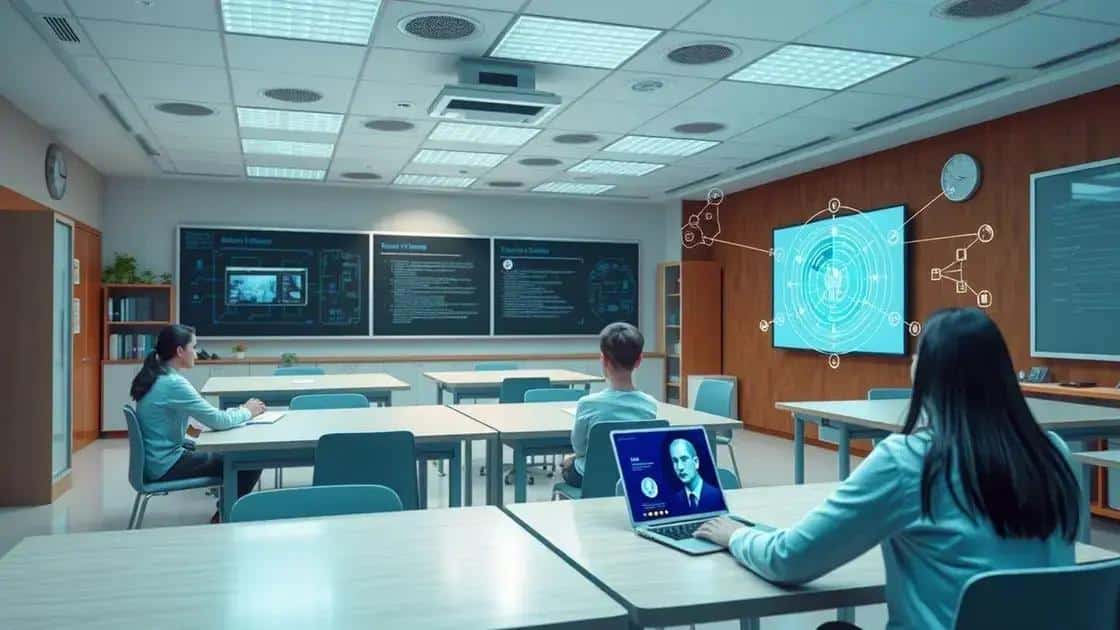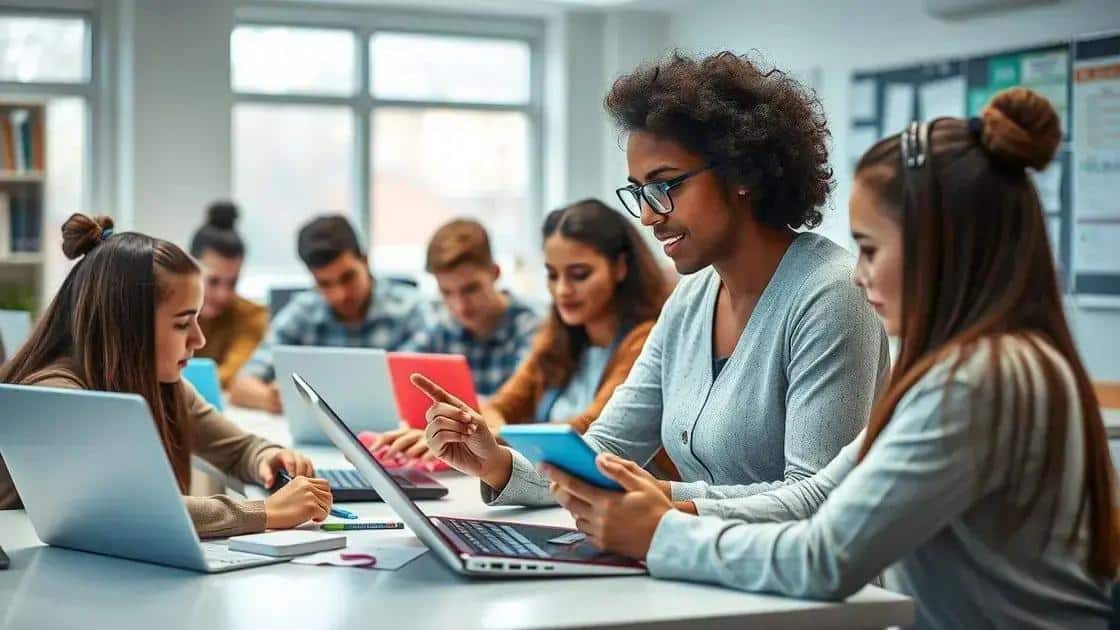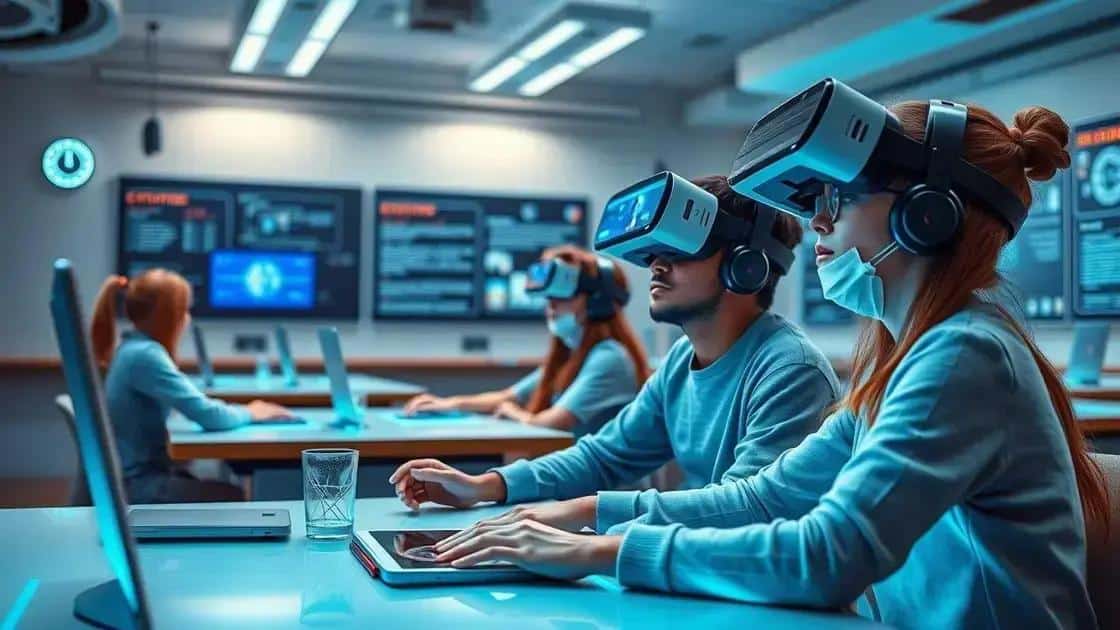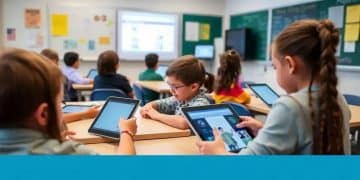Teacher AI tools 2025 trends: what to expect

AI tools in education enhance personalized learning, shift teachers’ roles to facilitators, improve accessibility for students with disabilities, and foster collaboration, preparing students for a technology-driven future.
Teacher AI tools 2025 trends are reshaping the educational landscape. Have you ever wondered how these emerging technologies will influence classroom dynamics? In this article, we’ll explore the latest innovations and what they mean for educators and students alike.
Emerging AI technologies in education
Emerging AI technologies in education are changing how teachers and students interact in the classroom. With innovative tools, educators can enhance learning experiences and make them more engaging.
Key AI Technologies Transforming Education
Several AI technologies are becoming essential in modern classrooms. These tools help streamline administrative tasks, provide personalized learning experiences, and support educators.
- Adaptive learning systems: These systems analyze student performance in real time, offering tailored resources.
- Automated grading tools: By using AI for grading, teachers can save time and provide quicker feedback.
- Virtual tutoring: AI-powered tutoring systems assist students outside the classroom, helping them strengthen their understanding.
- Learning analytics: This involves collecting data on student activity to inform teaching strategies.
In addition to these technologies, AI can enhance classroom management. By relieving teachers of mundane tasks, they can focus more on student engagement. Another fascinating aspect is using natural language processing to enable better communication between students and machines. This technology allows for more interactive learning environments.
AI can also facilitate multilingual support, helping non-native speakers learn and communicate effectively in their new academic settings. As we embrace these technologies, it’s important to remember the role of teachers in guiding and supporting their students in this AI-driven landscape.
With these advancements, educators need to be proactive in learning how to integrate AI into their everyday practices. This includes understanding which tools can best meet their students’ needs and staying updated on new developments.
Impact of AI tools on teaching methods

The impact of AI tools on teaching methods is significant and transformative. These tools are helping teachers improve their instruction and engage students more effectively.
Enhancing Personalized Learning
AI tools can gather data about student performance and learning habits. This data allows teachers to create customized lesson plans that meet individual needs.
- Tailored resources: AI can suggest materials that align with students’ skill levels.
- Real-time feedback: Educators receive instant insights on student progress, making adjustments easier.
- Targeted support: AI identifies areas where students struggle, enabling focused interventions.
Furthermore, these tools facilitate collaboration among students. AI-powered platforms encourage teamwork and help students communicate more efficiently. For example, virtual classrooms can host real-time discussions, where students can share ideas openly.
Teachers are also using AI to automate administrative tasks. Grading assignments and managing schedules takes time, but AI can handle these processes. By relieving educators of these burdens, they can dedicate more energy to enhancing student engagement and fostering creativity.
The Future of Classroom Dynamics
As AI continues to evolve, we can expect further changes in classroom dynamics. Traditional teaching methods will blend with technology, creating hybrid learning environments. This revolution could mean a shift from one-size-fits-all teaching to more fluid instructions that reflect each student’s pace.
The integration of AI tools in teaching is not just about technology; it’s about growth. Teachers who embrace these innovations can improve their effectiveness, leading to better educational outcomes for their students. As we’ve seen, the future promises exciting developments in how knowledge is shared and acquired.
How teachers can adapt to AI tools
Teachers can adapt to AI tools by embracing technology in their classrooms. This shift opens up new opportunities for enhancing student learning and engagement.
Understanding AI Tools
First, educators need to familiarize themselves with various AI tools available for teaching. These resources can include adaptive learning platforms, virtual tutors, and automated grading systems. Knowing what tools are out there is crucial in integrating them effectively into the classroom.
- Training programs: Participating in training can help teachers feel confident using AI.
- Peer support: Collaborating with colleagues can make adjusting to new tools easier.
- Online resources: Many websites offer tutorials and guidance on utilizing AI in education.
As teachers begin to implement these tools, they will notice how AI enhances lesson planning. For instance, AI can analyze student data to provide insights into learning patterns. This allows teachers to create personalized learning experiences tailored to individual student needs.
Another strategy is to incorporate AI tools in small steps. Rather than overhauling their entire teaching approach, educators can start with one tool at a time. This gradual adaptation can lead to more effective integration and less overwhelm.
Engaging Students with Technology
Utilizing AI tools can also help engage students more actively. These technologies often provide interactive elements that make learning fun and motivating. Teachers can encourage their students to use AI resources for research and problem-solving tasks, equipping them with valuable skills for the future.
It’s also important for teachers to maintain a balance between technology and human interaction. While AI can enhance learning, the personal connection between teachers and students remains vital. Therefore, educators should aim to use AI as a supplement to traditional teaching methods, enriching the overall learning experience.
Future predictions for AI in classrooms

Future predictions for AI in classrooms reveal exciting possibilities. As technology evolves, we can anticipate profound changes in how education is delivered.
Integration of Advanced AI Systems
In the coming years, schools are likely to integrate more advanced AI systems into their curriculums. Personalized learning experiences will become the norm, allowing each student to learn at their own pace. AI will analyze individual performance and adapt lessons accordingly, making learning more efficient.
- Smart classrooms: Classrooms may be equipped with AI that can respond to students’ needs in real time.
- Virtual reality: Imagine students exploring historical sites or scientific phenomena through VR, guided by AI.
- Enhanced teacher tools: Educators will use AI for grading, lesson planning, and identifying trends in student performance.
Moreover, AI may facilitate even greater collaboration among students. With tools that connect learners across the globe, classrooms could transform into diverse learning ecosystems. Students will engage in group projects with peers from various backgrounds, enhancing cultural awareness and understanding.
Changing Roles of Educators
As AI continues to advance, the role of teachers will shift. They’ll focus more on facilitating discussions and providing emotional support rather than merely delivering content. This change enables teachers to become guides in the learning process, helping students navigate their educational journeys.
AI is also expected to enhance accessibility in education. Students with disabilities may benefit significantly from AI-driven tools that cater to their unique needs. For example, speech recognition and assistive technologies will empower all learners to participate fully in classroom activities.
As we look forward to these developments, it is clear that integrating AI into classrooms holds great promise. This evolution not only enhances learning but also prepares students for a future where technology plays a central role in all aspects of life.
FAQ – Frequently Asked Questions about AI in Education
How will AI tools enhance student learning in classrooms?
AI tools provide personalized learning experiences, adapting resources to meet each student’s needs and helping them learn at their own pace.
What role will teachers play as AI becomes more integrated in education?
Teachers will shift from being the primary source of information to facilitators, guiding discussions and providing emotional support.
Will AI improve accessibility for students with disabilities?
Yes, AI-driven tools can offer customized support for students with disabilities, enabling them to participate fully in classroom activities.
How can schools prepare for the future integration of AI technologies?
Schools can prepare by investing in training for educators, exploring AI tools, and fostering a culture of innovation in teaching methods.





